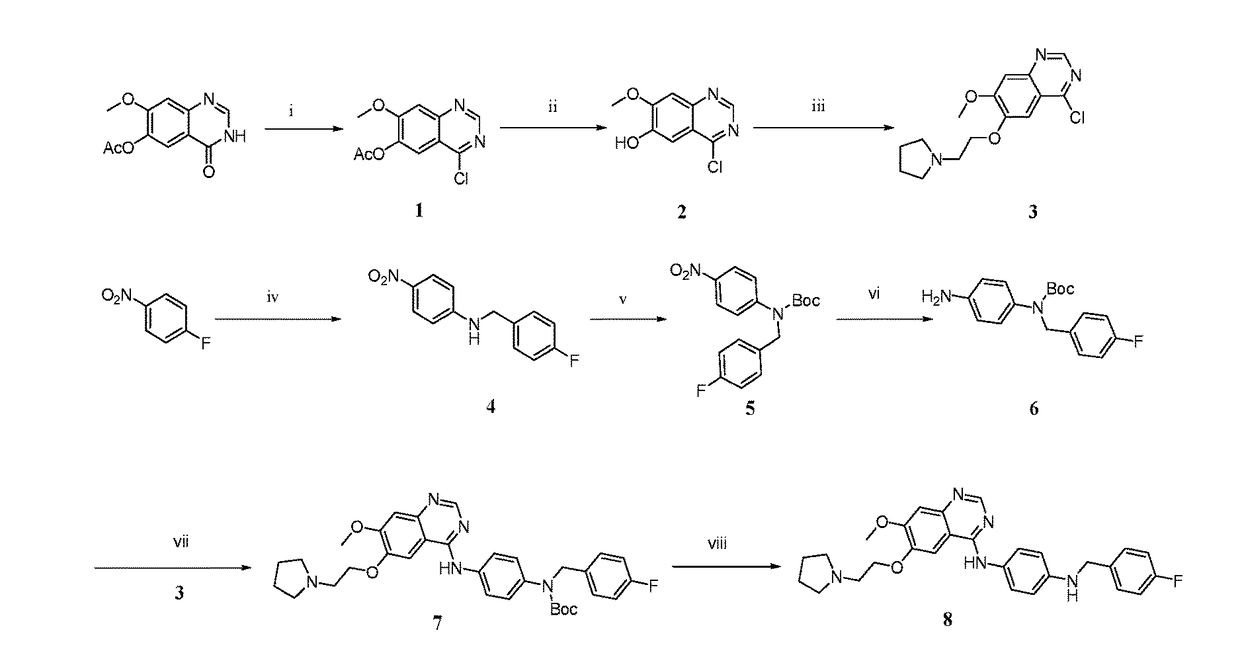Quinazoline derivative Lu1501 and preparing method and application thereof
- Summary
- Abstract
- Description
- Claims
- Application Information
AI Technical Summary
Benefits of technology
Problems solved by technology
Method used
Image
Examples
embodiment 1 prepare 4 -
Embodiment 1 Prepare 4-chloro-7-methoxy quinazolin-6-yl acetate (Compound 1)
[0030]1000 mL sulfoxide chloride (SOCl2) was added into 2000 mL nitrogen-protected four-neck round-bottom flask, 10 mL DMF was dropwise added slowly for catalyzing (dropwise added in 20 min), then 100 g 7-methoxy-4-oxo-3,4-dihydro-quinazolin-6-yl acetate was added, and stirred for 3 h under 100□. The reaction fluid is cooled to room temperature in an ice bath, subjected to vacuum concentration, dried and then dissolved with 1000 mL dichloromethane, and then 1000 mL ice water was poured in. A mixture fluid was extracted by twice using dichloromethane to combine an organic layer, and then were washed by thrice using saturated aqueous sodium chloride solution. The organic layer was separated out and dried for 6 h in a 250 mL triangular flask by adding anhydrous sodium sulfate, then was subjected to vacuum filtration. The filtrate was subjected to vacuum concentration and dried, and washed by diethyl-ether, thus...
embodiment 2 prepare 4 -
Embodiment 2 Prepare 4-chloro-7-methoxy quinazolin-6-ol (Compound 2)
[0031]10 g 4-chloro-7-methoxy quinazolin-6-yl acetate (compound 1) was placed into a 250 mL three-neck round-bottom flask, 100 mL 7M NH3-methanol solution was dropwise added while being stirred in an ice bath, and completely dropwise added in 30 min. The stirring reaction was performed for more than 30 min under 100. The reaction fluid was subjected to vacuum filtration, then a filtration residue was washed by twice using diethyl-ether, thus obtaining 6.5 g (yield 78%) compound 2, which was pale yellow powder.
embodiment 3 prepare 4 -
Embodiment 3 Prepare 4-chloro-7-methoxy-6-[(2-pyrrolidin-1-yl)hydroxyethyl]quinazoline (Compound 3)
[0032]6.5 g 4-chloro-7-methoxy quinazolin-6-ol (compound 2), 4.6 g N-(2-hydroxyethyl)pyrrolidine, and 10.54 g PPh3 were dissolved into 120 mL tetrahydrofuran, placed in a 250 mL nitrogen-protected three-neck round-bottom flask, and 9.25 g DTAD was added by three batches with an interval of 3 h / times under an ice bath, and stirred for 12 h under a room temperature. 100 mL water was added for terminating the reaction, and the reaction fluid was extracted by thrice using 200 mL dichloromethane to combine an organic layer, and then was washed by once using saturated aqueous sodium chloride solution. The organic layer was separated out and dried for 6 h in a 250 mL triangular flask by adding anhydrous sodium sulfate, then was subjected to vacuum filtration. The filtrate was subjected to vacuum concentration and dried, and then subjected to column chromatography, thus obtaining 4 g (yield 42...
PUM
| Property | Measurement | Unit |
|---|---|---|
| Temperature | aaaaa | aaaaa |
| Temperature | aaaaa | aaaaa |
| Temperature | aaaaa | aaaaa |
Abstract
Description
Claims
Application Information
 Login to View More
Login to View More - R&D
- Intellectual Property
- Life Sciences
- Materials
- Tech Scout
- Unparalleled Data Quality
- Higher Quality Content
- 60% Fewer Hallucinations
Browse by: Latest US Patents, China's latest patents, Technical Efficacy Thesaurus, Application Domain, Technology Topic, Popular Technical Reports.
© 2025 PatSnap. All rights reserved.Legal|Privacy policy|Modern Slavery Act Transparency Statement|Sitemap|About US| Contact US: help@patsnap.com


